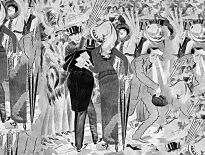Linda Raschke – The Music of the Markets

Today’s post is a profile of Guru investor Linda Raschke, who appears in Jack Schwager’s book New Market Wizards. Her chapter is called the Music of the Markets.
Linda Raschke
Linda Bradford Raschke started out helping her father with chart patterns.
- He was a keen trader but never made any money at it.
She wanted to be a stockbroker after college, but couldn’t get a trading job.
- So she started hanging out on the floor of the Pacific Coast Stock Exchange every morning before work as a financial analyst at a paper company.
Eventually this led to her becoming an options trader rather than taking her MBA.
She spent six years as a floor trader, moving to Philadelphia.
- In 1986, she had a horse-riding accident and discovered that she much preferred trading from an office (at home).
She appears in Jack Schwager’s book “New Market Wizards”.
- Her chapter is called the Music of the Markets.
Trading style
I truly feel that I could give away all my secrets and it wouldn’t make any difference. Most people can’t control their emotions or follow a system.
Also, most traders wouldn’t follow my system, even if I gave them step-by-step instructions, because my approach wouldn’t feel right to them. They wouldn’t have the same confidence or comfort in the trading method as I do.
My niche is short-term trading. I believe that only short-term price swings can be predicted with any precision. I’m a strong believer in chaos theory.
Most readers will be familiar with the Butterfly Effect – the idea that small changes in inputs can produce large changes in outputs.
There are too many unpredictable things that can happen within two months. To me, the ideal trade lasts ten days, but I approach every trade as if I’m only going to hold it two or three days.
I don’t set price targets. I get out when the market action tells me it’s time to get out.
I put a great deal of effort into getting the best entry price possible. In day trading, a good entry price is critical because it buys you time to see how the market will react.
You can picture price fluctuations around an equilibrium level as a rubber band being stretched – if it gets pulled too far, eventually it will snap back. As a short-term trader, I try to wait until the rubber band is stretched to its extreme point.
One of my favorite patterns is the tendency for the markets to move from relative lows to relative highs and vice versa every two to four days. It takes several days of a market rallying before it looks really good. That’s when everyone wants to buy it, and that’s the time when the professionals are selling.
I don’t think the specific choice of indicators is that critical, as long as you have a good feel for interpreting the indicators that you use.
Personally, I pay close attention to the tick [the difference between the number of issues whose most recent tick was up and those whose most recent tick was down], TRIN [a measure that relates the price and volume of advancing issues to the corresponding figures for declining issues], and premium [the premium, or discount, of stock index futures to the theoretically equivalent cash index price].
My number one rule is: don’t try to make a profit on a bad trade, just try to find the best place to get out. Once I’m out, it’s easy for me to get back in.
Mistakes
My own particular weakness has always been being a bit premature on entering positions. I’ve learned to think to myself, “Patience, patience, patience.”
I try to wait until things set up just right before I take a trade. It’s better to have the wrong idea and good timing than the right idea and bad timing.
Another mistake I’ve frequently made is participating in too many markets at one time, which leads to sloppy trading. I analyze twenty markets. But at any given time, I trade no more than about six markets.
I’ve also found that it’s my smallest positions that cause my biggest losses, because they tend to be neglected. It’s natural to be cautious and attentive to big positions.
Numbers
Raschke has 70% profitable trades, and her winners are about double the average size of her losers.
My philosophy is to try to be profitable every day! I’m probably profitable nearly every week.
Perfection may be elusive, but consistency is achievable if you practice day in and day out.
Pattern recognition
I believe my most important skill is an ability to perceive patterns in the market. I think this aptitude for pattern recognition is probably related to my heavy involvement with music.
Between the ages of five and twenty-one, I practiced piano for several hours every single day. In college, I had a dual major of economics and musical composition. Musical scores are just symbols and patterns.
Sitting there for hours every day, analyzing scores, probably helped that part of my brain related to pattern recognition. Also, practicing an instrument for several hours every day helps develop discipline and concentration – two skills that are very useful as a trader.
A musical piece has a definite structure: there are repeating patterns with variations. Musical pieces have quiet interludes, theme development, and a gradual crescendo to a climax.
You must have patience as a musical piece unfolds and patience until a trade sets up. You can practice, practice, practice, but you’re never going to play a musical piece perfectly, just as you’re never going to buy the low and sell the high on a trade.
All you can hope to do is to play a piece (or trade) better than before. In both music and trading, you do best when you’re relaxed, and in both you have to go with the flow.
You must be able to read individual notes and learn a piece of music measure by measure before you can play the whole piece through. Perhaps that’s why I spend most of my energy on short-term trades rather than analyzing the long-term picture.
Advice
Learning the markets can take years. Immerse yourself in the world of trading and give up everything else. Get as close to other successful traders as you can.
Never fear the markets. Never fear making a mistake. If you do make a mistake, don’t complicate the position by trying to hedge it- just get out.
Develop your own routine for taking periodic market readings.
Never be greedy. It’s OK to leave money on the table.
If you can’t get in at a favorable price, let the trade go and start looking for the next trade.
A trader is someone who does his own work, has his own game plan, and makes his own decisions.
Only by acting and thinking independently can a trader hope to know when a trade isn’t working out. If you ever find yourself tempted to seek out someone else’s opinion on a trade, that’s usually a sure sign that you should get out of your position.
Conclusions
I didn’t know much about Linda Raschke before reading this chapter, but I found her approach engaging, and she’s pretty quotable.
- Unfortunately, her short-term, pattern recognition style is about as far away from my own as it’s possible to be.
Schwager says:
One of the primary common characteristics I have found among the great traders is an almost compelling sense of confidence in their ability to succeed. Linda Raschke personifies this type of confidence.
He also notes his own belief that markets are predictable over the long-term, but not the short term.
- This is the opposite to what Raschke believes – she sees the markets as more like weather forecasting.
Schwager concludes that she must be right, because her track record shows that she can spot the patterns.
I’m on the fence about this, but it doesn’t matter anyway.
- Because even if Raschke can spot the patterns, I’m sure that I couldn’t – at least not without the help of a computer.
Until next time.


















